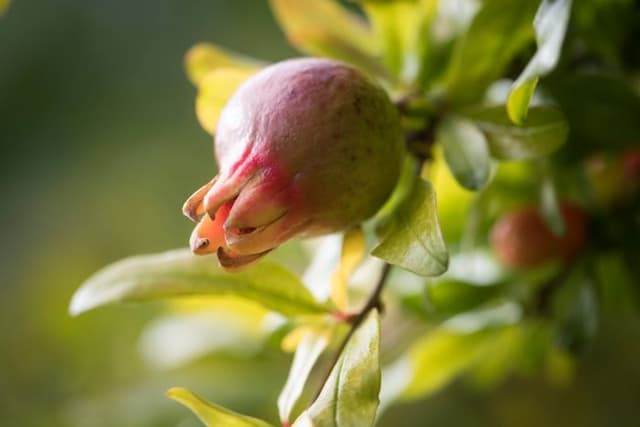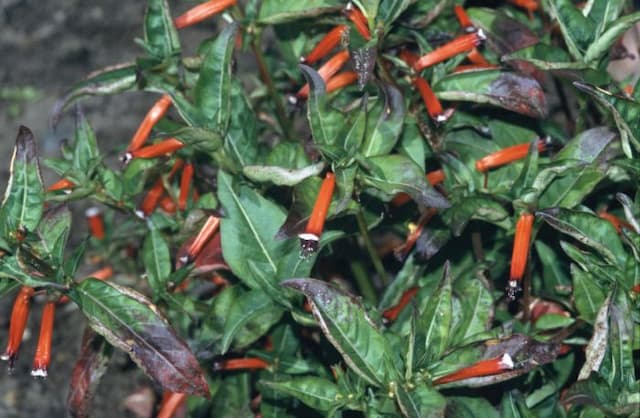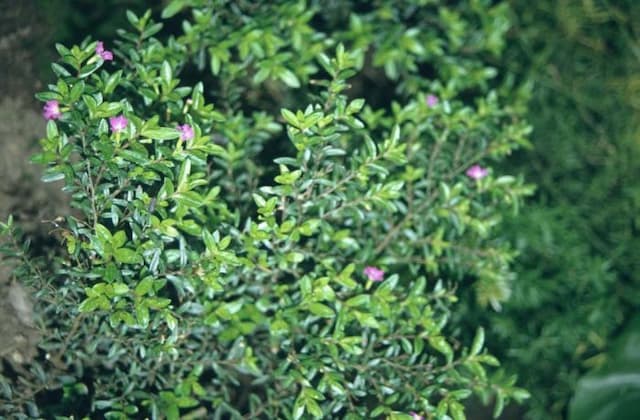Purple Loosestrife Lythrum salicaria 'Feuerkerze'

ABOUT
Lythrum salicaria 'Feuerkerze', commonly known as Purple Loosestrife 'Feuerkerze', is a striking perennial plant known for its vibrant flower spikes. It features long, erect stems that are robust and square in cross-section. The foliage is lance-shaped with a slightly heart-shaped base, producing a lush green background that beautifully contrasts the bright flowers. The most captivating aspect of 'Feuerkerze' is its flowers. They bloom in dense, showy spikes that are composed of many small, star-shaped blossoms. The color of the flowers ranges from a deep, rich magenta to a lighter shade of purple. These flowers are tightly packed along the spikes, creating an eye-catching display that stands out in any garden setting. Purple Loosestrife 'Feuerkerze' is known to attract wildlife, such as bees and butterflies, which are drawn to its flowers for nectar. The blooming period typically occurs during the summer months, when the plant is at its most visually appealing. The combination of the striking flowers and the lush greenery makes this variety of Purple Loosestrife a popular choice among gardeners seeking a plant with a long season of interest.
About this plant
 Names
NamesSynonyms
Purple Loosestrife, Rosy Strife, Spiked Loosestrife, Purple Lythrum, Salad Dodder, Feuerkerze
Common names
Lythrum salicaria 'Blush', Lythrum salicaria 'Morden Gleam', Lythrum salicaria 'Morden Pink', Lythrum salicaria 'Robert', Lythrum salicaria 'Zigeunerblut'.
 Toxicity
ToxicityTo humans
Purple loosestrife, the common name for Lythrum salicaria 'Feuerkerze', is not known to be toxic to humans. There are no well-documented cases or symptoms of poisoning from ingesting any part of this plant.
To pets
Purple loosestrife is also not recognized as a toxic plant to pets. It does not typically cause poisoning or notable symptoms if ingested by animals. However, it's always advisable to prevent pets from consuming non-food plants, as individual reactions can vary.
 Characteristics
CharacteristicsLife cycle
Perennials
Foliage type
Deciduous
Color of leaves
Green
Flower color
Pink
Height
3-4 feet (0.9-1.2 meters)
Spread
1-3 feet (0.3-0.9 meters)
Plant type
Herb
Hardiness zones
4-9
Native area
Europe Asia
Benefits
 General Benefits
General Benefits- Attracts Wildlife: Provides nectar for bees, butterflies, and other pollinators, thus supporting biodiversity.
- Garden Ornamentation: Offers bright magenta spikes of flowers that add color and visual interest to gardens from summer to early autumn.
- Erosion Control: With its dense root system, Purple Loosestrife can help prevent soil erosion along stream banks and wetlands.
- Wetland Habitat Enhancement: Often used for habitat restoration projects, as it thrives in damp environments.
- Drought Tolerance: Once established, it shows a good level of resistance to drought, reducing the need for regular watering.
- Low Maintenance: Requires minimal care once established, making it suitable for low-maintenance landscaping.
- Deer Resistance: Generally resistant to browsing by deer, which can protect other more vulnerable plants in the garden.
 Medical Properties
Medical PropertiesThis plant is not used for medical purposes.
 Air-purifying Qualities
Air-purifying QualitiesThis plant is not specifically known for air purifying qualities.
 Other Uses
Other Uses- Purple loosestrife 'Feuerkerze' can be used as a natural dye, yielding a variety of purple and mauve shades when the flowers are boiled and used in dyeing textiles.
- The dried stalks of purple loosestrife can be used in floral arrangements, adding height and a touch of wild beauty to the composition.
- This plant's ability to grow in wet conditions can be utilized for waterway bank stabilization, helping to prevent soil erosion with its extensive root system.
- The tall, dense growth habit of purple loosestrife makes it suitable for creating privacy screens or living fences in garden settings.
- Purple loosestrife can be planted as part of a rain garden to help with water absorption and reducing runoff in areas prone to heavy rainfall.
- Its presence in constructed wetlands aids in the treatment of wastewater by absorbing nutrients and pollutants through phytoremediation.
- The flowers of purple loosestrife can be used to produce a light, fragrant honey when cultivated near apiaries, as bees are attracted to its nectar.
- It can be incorporated into ecological art installations that focus on native and invasive species, stimulating conversations about local biodiversity.
- Purple loosestrife's dense growth can also be beneficial as a windbreak to protect soil and smaller plants from heavy winds.
- Educational use in biology classes or ecological studies to demonstrate the impacts of invasive species on native plants and ecosystems.
Interesting Facts
 Feng Shui
Feng ShuiPurple Loosestrife is not used in Feng Shui practice.
 Zodiac Sign Compitability
Zodiac Sign CompitabilityPurple Loosestrife is not used in astrology practice.
 Plant Symbolism
Plant Symbolism- Healing: Lythrum salicaria, commonly known as Purple Loosestrife, has been used medicinally to treat various ailments, symbolizing healing and restoration of health.
- Persistent Growth: The Purple Loosestrife is known for its vigorous growth and ability to thrive in a variety of conditions, symbolizing perseverance and the tenacity of life.
- Strife: Its name 'loosestrife' can be associated with the word 'strife,' symbolizing conflict or struggle, possibly due to its invasive nature in some regions.
- Attractiveness: With its striking purple spikes of flowers, Purple Loosestrife symbolizes attraction and the ability to grab attention, resonating with its eye-catching presence in the wild.
 Water
WaterPurple loosestrife 'Feuerkerze' thrives when consistently moist, so water it thoroughly, ensuring that the soil never dries out completely. An average watering routine could involve applying about 1 gallon of water per week during regular weather conditions, but this may need to increase during particularly hot or dry spells to maintain soil moisture. It's essential to adjust watering based on rainfall and temperature changes since overwatering can be as harmful as under watering.
 Light
LightPurple loosestrife 'Feuerkerze' prefers full sun to partial shade, so the best spot for it would be an area that receives at least six hours of direct sunlight daily. While it can tolerate light shade, an abundance of sunlight will promote the best flowering. Keep it out of deep shade to ensure vibrant growth and blooms.
 Temperature
TemperaturePurple loosestrife 'Feuerkerze' can tolerate a wide temperature range but ideally should be situated in environments where the temperature stays between 60 and 75 degrees Fahrenheit. It can survive temperatures as low as -20 degrees Fahrenheit and as high as 90 degrees Fahrenheit, but prolonged exposure to extremes outside the ideal range may stress the plant.
 Pruning
PruningPurple loosestrife 'Feuerkerze' should be pruned primarily to remove spent flowers and encourage a second bloom, as well as to maintain its shape and promote vigorous growth. It's best to prune or deadhead after the initial flowering has ceased, usually in late summer or early fall. Additionally, evaluating the plant in the spring to remove any dead or damaged stems from the winter is beneficial.
 Cleaning
CleaningAs needed
 Soil
SoilPurple Loosestrife 'Feuerkerze' thrives in moist, fertile soil with good drainage. A mix of two parts loam, one part peat, and one part sand can work well. The ideal soil pH for Purple Loosestrife is between 5.5 and 7.5.
 Repotting
RepottingPurple Loosestrife 'Feuerkerze' does not require frequent repotting. It should be repotted only when the root system outgrows the container, which may be every 2-3 years.
 Humidity & Misting
Humidity & MistingPurple Loosestrife 'Feuerkerze' is adaptable but prefers high humidity. The best humidity level is above 50%, similar to its natural wetland habitat.
 Suitable locations
Suitable locationsIndoor
Provide bright, indirect light and keep soil moist.
Outdoor
Plant in full sun to partial shade in wet areas.
Hardiness zone
3-9 USDA
 Life cycle
Life cyclePurple Loosestrife 'Feuerkerze' begins its life cycle as a seed that germinates in early spring in moist soils. Upon germination, the seedling develops a rosette of leaves near the ground level. As it matures during the spring and early summer, it elongates and forms a sturdy stem, alongside which lance-shaped leaves are arranged in pairs or whorls. Throughout summer, it produces striking spikes of rose-pink to purple flowers that are attractive to bees and butterflies. After pollination, typically by insects, the plant sets seed in late summer to early fall, which are dispersed by water, wind, or animals. The plant then enters a period of dormancy during winter, dying back to the ground if subjected to frost, and re-emerges from its root system the following spring to complete the cycle.
 Propogation
PropogationPropogation time
Summer-early fall
The most popular method of propagating Purple Loosestrife 'Feuerkerze', formally known as Lythrum salicaria 'Feuerkerze', is through division. This is typically done in early spring or fall when the plant is not in active bloom. To propagate by division, carefully dig up the plant and gently separate the root clump into smaller sections ensuring that each section has a portion of the root system and a few shoots. These divisions can then be replanted into moist soil at the same depth they were originally growing. It is crucial to keep the newly planted divisions well-watered until they are established. This method creates clones of the parent plant and is quite effective for expanding your garden or sharing with fellow garden enthusiasts.




